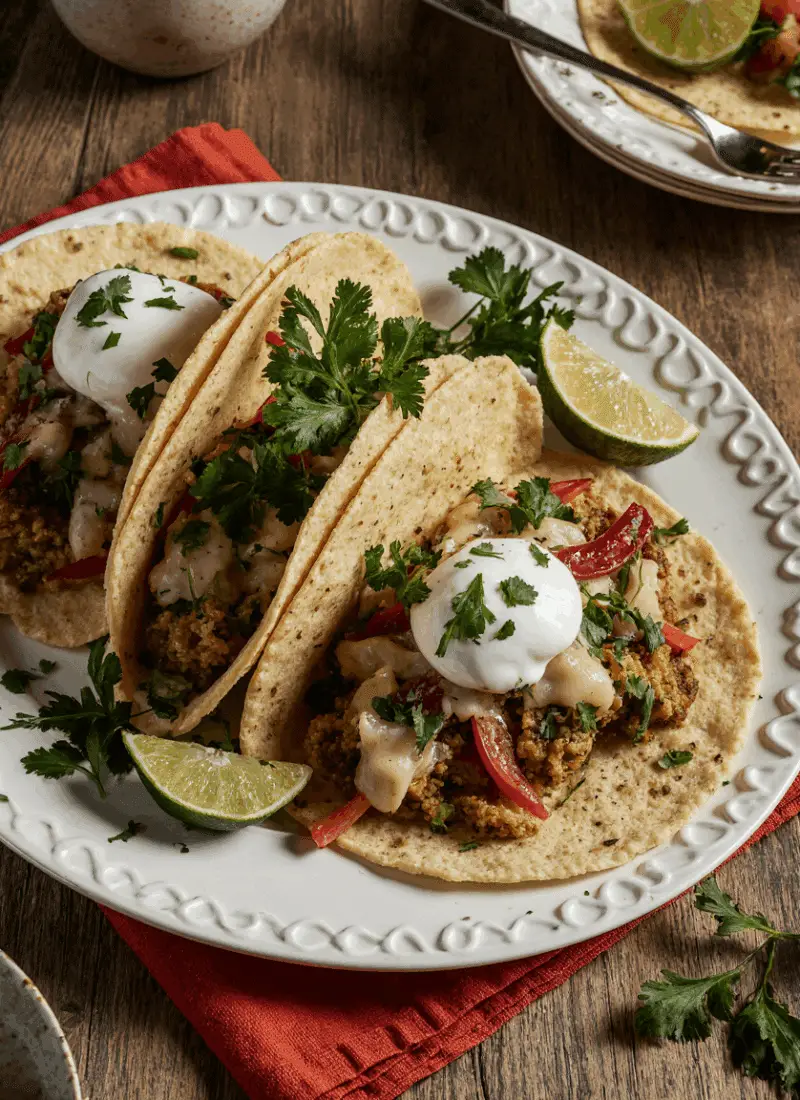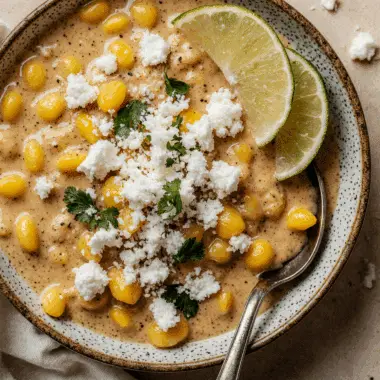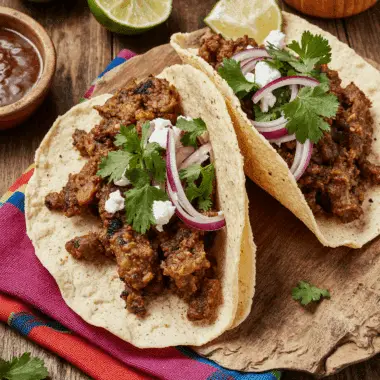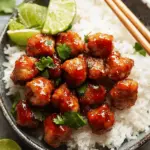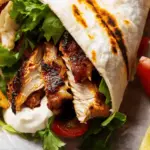Tlacoyos are thick, oval-shaped masa cakes that are traditionally stuffed with beans, cheese, or fava beans, then grilled on a comal and topped with vibrant garnishes like salsa, nopales, onions, and queso fresco. This cherished Mexican street food is especially popular during festivities such as Mexican Independence Day, offering a combination of hearty flavor and cultural heritage.
FULL RECIPE
Ingredients
- 2 cups masa harina (corn flour)
- 1 ½ cups warm water (more if needed)
- ½ teaspoon salt
- 1 cup refried black beans (or mashed cooked fava beans or requesón cheese)
- 1 tablespoon vegetable oil (for cooking)
- Optional toppings:
- Nopalitos (cooked cactus paddles)
- Salsa roja or verde
- Chopped onions
- Chopped cilantro
- Crumbled queso fresco
- Mexican crema
Directions
- Prepare the masa dough: In a large mixing bowl, combine masa harina and salt. Gradually pour in warm water, mixing with your hands until a soft, pliable dough forms. If the dough feels too dry or cracks, add more water a tablespoon at a time.
- Divide and shape: Divide the dough into 8 equal portions. Roll each portion into a ball, then flatten into a thick disc about 5 inches wide.
- Fill and seal: Place about 1 to 1½ tablespoons of your chosen filling (beans, cheese, or fava beans) in the center of the disc. Fold the dough over to encase the filling and gently shape into an oval, pinching the edges to seal.
- Flatten: Carefully press the stuffed dough into a flat oval shape about ¼ inch thick. You can use your hands or a tortilla press lined with plastic wrap.
- Preheat the cooking surface: Heat a large, dry comal or skillet over medium heat. Once hot, place the tlacoyos on the surface and cook for 3–4 minutes per side, or until golden and cooked through. If desired, brush with a little oil for a lightly crispy finish.
- Top and serve: Remove tlacoyos from the pan and immediately top with salsa, nopalitos, onions, queso fresco, cilantro, and crema. Serve warm.
Nutrition Facts
- Calories: 230
- Total Fat: 6g
- Saturated Fat: 2g
- Cholesterol: 5mg
- Sodium: 180mg
- Total Carbohydrates: 35g
- Dietary Fiber: 4g
- Sugars: 1g
- Protein: 7g
- Calcium: 60mg
- Iron: 1.8mg
- Potassium: 210mg
Cultural Significance of Tlacoyos
Tlacoyos are deeply rooted in Mexican heritage, originating from the central valleys of pre-Hispanic Mesoamerica, particularly among the Aztecs. These oval-shaped masa cakes were a staple in indigenous diets and are still found in bustling Mexican markets today. Their cultural importance extends beyond nutrition; they embody ancestral traditions passed down through generations. During Mexican Independence Day, tlacoyos gain special prominence, offering a taste of national identity and pride. Their preparation, often a communal activity, becomes a celebration of culture and community resilience.
Nutritional Benefits of Masa and Bean Fillings
One of the defining characteristics of tlacoyos is their wholesome nutritional value. The base of masa harina (made from nixtamalized corn) is rich in complex carbohydrates and contains essential nutrients like calcium and fiber. When combined with refried black beans or mashed fava beans—both excellent plant-based proteins—tlacoyos provide a balanced, nutrient-dense meal. Black beans, for instance, are high in folate, magnesium, and antioxidants. The inclusion of toppings such as nopales and salsa further enhances the fiber, vitamin C, and antioxidant profile, making this dish both satisfying and nourishing.
Common Variations and Regional Styles
Though black beans are the most common filling, tlacoyos offer plenty of room for creativity and regional flair. In Puebla and the State of Mexico, they might be filled with requesón (a type of fresh cheese), while in Oaxaca, fava beans or chicharrón (fried pork skin) are more popular. Some versions are brushed with lard before being grilled for extra richness, while others are kept vegetarian with a topping of lightly sautéed vegetables. In more urban settings, tlacoyos may come loaded with modern twists like avocado slices, grilled chicken, or even spicy pickled vegetables.
Tips for Perfectly Shaped and Cooked Tlacoyos
Making tlacoyos by hand can be a satisfying process, but a few tips help ensure ideal results. The masa should be moist but not sticky, with a smooth texture that’s easy to shape without cracking. When sealing the filling, gentle pressure and wet fingers help form a tight seal, preventing leakage during cooking. Flattening the filled dough into an even oval without exposing the filling is key. A hot, dry comal or cast-iron skillet ensures even cooking and develops a light char that brings out the nutty flavor of the masa. Brushing with a little oil can give them a desirable crisp finish.
Serving Suggestions and Presentation Ideas
Tlacoyos are traditionally served hot and topped with a mix of fresh and cooked ingredients. To present them festively for a celebration like Mexican Independence Day, consider creating a topping bar with colorful options: vibrant salsas, crumbly queso fresco, chopped cilantro, pickled onions, and sautéed nopales. Arrange the tlacoyos on a large platter or wooden board, letting guests build their own. Pairing the tlacoyos with traditional drinks like horchata or tamarindo enhances the cultural experience. For a sit-down dinner, two tlacoyos per plate with a side of elote (Mexican street corn) makes for a hearty and visually appealing dish.
Pairing Tlacoyos with Side Dishes and Beverages
Tlacoyos pair beautifully with a range of Mexican sides and beverages. A fresh side salad of jicama, orange, and chili powder can add a crunchy, citrusy contrast. Traditional soups like sopa de tortilla or caldo de pollo serve as comforting accompaniments. In terms of drinks, aguas frescas (like hibiscus or cucumber-lime) are refreshing choices. If serving for a festive evening gathering, a smoky mezcal cocktail or a light Mexican lager complements the hearty, earthy flavor of the masa and beans. For a non-alcoholic option, a glass of chilled atole makes an interesting textural and cultural pairing.
Storage Tips and Reheating Techniques
Tlacoyos store well in the refrigerator for up to three days when kept in an airtight container. To prevent them from drying out, wrap them in a slightly damp cloth before sealing. For longer storage, tlacoyos can be frozen (uncooked or cooked) with layers of parchment paper between each to avoid sticking. When ready to eat, reheat on a skillet over medium heat until warmed through and slightly crisped. Avoid microwaving, as it can lead to soggy or unevenly heated results. If frozen, allow them to thaw in the refrigerator overnight before reheating.
Gluten-Free and Vegetarian-Friendly Features
Tlacoyos are naturally gluten-free, as they are made with masa harina derived from corn. This makes them an excellent option for individuals with celiac disease or those following a gluten-free lifestyle. The typical fillings—black beans, cheese, or fava beans—are all vegetarian, making the base recipe suitable for meat-free diets. Toppings like nopales, salsas, and Mexican crema also cater to vegetarian preferences. To make the recipe fully vegan, simply use vegan refried beans and omit the dairy-based toppings or substitute with plant-based alternatives like almond crema or vegan cheese.
Traditional vs. Modern Preparation Methods
Traditionally, tlacoyos were made by hand and cooked over open fires on clay comales, often with women using inherited techniques and passing them down to the next generation. These methods are still alive in rural areas and markets, preserving authenticity. However, modern kitchens allow for more convenience with non-stick skillets or electric griddles. While the ingredients remain largely the same, contemporary variations might use pre-made masa or flavor-enhanced versions like blue corn or masa blended with herbs. Some even use air fryers or oven baking methods to reduce oil usage while maintaining texture.
Why Tlacoyos Are Perfect for Celebrations
Hearty, portable, and highly customizable, tlacoyos are ideal for festive occasions such as Mexican Independence Day. Their preparation can be a shared experience among friends and family, bringing people together in the spirit of tradition and celebration. Since they can be made in advance and reheated, they’re perfect for large gatherings. The ability to create a tlacoyo “toppings bar” adds an interactive element to the meal, allowing guests to personalize their food and explore new flavors. Their bold colors and rustic charm also add visual appeal to any festive table setting.
Conclusion
Tlacoyos are more than just a delicious meal they are a cultural experience wrapped in masa and filled with tradition. Their blend of history, health benefits, and adaptability makes them a standout choice for anyone looking to celebrate Mexican cuisine, especially during significant national holidays like Mexican Independence Day.

